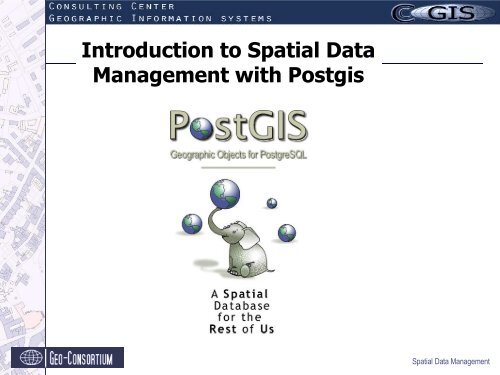Introduction to Spatial Data Management with PostGIS - Mapbender
Introduction to Spatial Data Management with PostGIS - Mapbender
Introduction to Spatial Data Management with PostGIS - Mapbender
Create successful ePaper yourself
Turn your PDF publications into a flip-book with our unique Google optimized e-Paper software.
<strong>Introduction</strong> <strong>to</strong> <strong>Spatial</strong> <strong>Data</strong><br />
<strong>Management</strong> <strong>with</strong> Postgis<br />
<strong>Spatial</strong> <strong>Data</strong> <strong>Management</strong>
Content<br />
● <strong>Introduction</strong><br />
● Managing <strong>Spatial</strong> <strong>Data</strong> <strong>with</strong> <strong>PostGIS</strong><br />
● <strong>PostGIS</strong> <strong>Data</strong> Model<br />
● Creating a <strong>PostGIS</strong> enabled <strong>Data</strong>base<br />
● Insert Coordinates using SQL<br />
● Uploading Flat File GIS <strong>Data</strong><br />
● Using <strong>Spatial</strong> Opera<strong>to</strong>rs<br />
● Creating <strong>Spatial</strong> Index<br />
● Creating Maps <strong>with</strong> <strong>PostGIS</strong> <strong>Data</strong> using UMN MapServer<br />
● Online Demonstration of a WebGIS Application<br />
<strong>Spatial</strong> <strong>Data</strong> <strong>Management</strong>
Abstract: What is <strong>PostGIS</strong>?<br />
● <strong>PostGIS</strong> is a spatial language extension module <strong>to</strong> the<br />
PostgreSQL backend server<br />
● The OGC WKT (Well-Known Text) and WKB (Well-Known<br />
Binary) form define type and coordinates of an object<br />
● <strong>Data</strong> from a PostgreSQL/<strong>PostGIS</strong> database can be used as data<br />
source for spatial server software like MapServer and GeoServer<br />
● <strong>PostGIS</strong> is licensed under the GNU GPL and operated as a Free<br />
Software Project<br />
● <strong>PostGIS</strong> is developed by Refractions Research Inc, a GIS and<br />
database consulting company in Vic<strong>to</strong>ria, British Columbia,<br />
Canada<br />
● http://postgis.refractions.net<br />
<strong>Spatial</strong> <strong>Data</strong> <strong>Management</strong>
Who did it? Credits <strong>to</strong>...<br />
Sandro Santilli (strk@refractions.net) coordinates all bug fixing and maintainance effort,<br />
integration of new GEOS functionality, and new function enhancements.<br />
Chris Hodgson (chodgson@refractions.net) Maintains new functions and the 7.2 index<br />
bindings.<br />
Paul Ramsey (pramsey@refractions.net) Maintains the JDBC objects and keeps track of<br />
the documentation and packaging.<br />
Jeff Lounsbury (jeffloun@refractions.net) Original development of the Shape file<br />
loader/dumper.<br />
Dave Blasby (dblasby@gmail.com) The original developer of <strong>PostGIS</strong>. Dave wrote the<br />
server side objects, index bindings, and many of the server side analytical functions.<br />
Other contribu<strong>to</strong>rs in alphabetical order:<br />
Alex Bodnaru, Bernhard Reiter, Bruno Wolff III, Carl Anderson, David Skea, David Techer,<br />
IIDA Tetsushi, Geographic <strong>Data</strong> BC, Gerald Fenoy, Gino Lucrezi, Klaus Foerster, Kris Jurka,<br />
Mark Cave-Ayland, Mark Sondheim, Markus Schaber, Nikita Shulga, Norman Vine, Olivier<br />
Courtin, Ralph Mason, Steffen Macke.<br />
<strong>Spatial</strong> <strong>Data</strong> <strong>Management</strong>
PostgreSQL Architecture <strong>with</strong> Client Applications<br />
PostgreSQL is implemented as a client server system<br />
User 1<br />
(databaseclient)<br />
User 2<br />
(database<br />
client)<br />
PostgreSQL database server postmaster<br />
<strong>Data</strong><br />
Applications<br />
Web Server<br />
Map Server<br />
<strong>Spatial</strong> <strong>Data</strong> <strong>Management</strong>
Foucs of Interest for this Presentation<br />
<strong>PostGIS</strong> spatial language extension module <strong>to</strong> the backend server<br />
User 1<br />
(databaseclient)<br />
User 2<br />
(database<br />
client)<br />
PostgreSQL database server postmaster<br />
<strong>Data</strong><br />
Applications<br />
Web Server<br />
Map Server<br />
<strong>PostGIS</strong><br />
<strong>Spatial</strong> <strong>Data</strong> <strong>Management</strong>
Overview: <strong>PostGIS</strong> <strong>Spatial</strong> <strong>Data</strong> <strong>Management</strong><br />
● <strong>PostGIS</strong> is implemented compliant <strong>to</strong> the OGC Simple Feature<br />
Specifications for SQL standard<br />
● The OGC specification defines operations and the SQL schema <strong>to</strong><br />
insert, query, manipulate and delete spatial objects<br />
● The coordinates of the spatial objects are s<strong>to</strong>red in Feature Tables<br />
● One Feature Table can contain one type of geometry (point, line,<br />
polygon, multiple of each and geometry collection)<br />
● The coordinates of each object is s<strong>to</strong>red in a field of a special type<br />
● The field type for a set of coordinates is WKT (Well Known Text)<br />
● Meta data is collected for each Feature Table <strong>to</strong> organize the type<br />
and the coordinate system of the contained geometry<br />
● The meta data for each Feature Table is s<strong>to</strong>red in the special table<br />
geometry_columns<br />
<strong>Spatial</strong> <strong>Data</strong> <strong>Management</strong>
<strong>Spatial</strong> <strong>Data</strong> Type WKT as defined by the OGC<br />
WKT Examples:<br />
POINT(2572292.2 5631150.7)<br />
LINESTRING (2566006.4 5633207.9, 2566028.6 5633215.1, 2566062.3 5633227.1)<br />
MULTILINESTRING((2566006.4 5633207.9, 2566028.6 5633215.1), (2566062.3<br />
5633227.1, 2566083 5633234.8))<br />
POLYGON (2568262.1 5635344.1, 2568298.5 5635387.6, 2568261.04 5635276.15,<br />
2568262.1 5635344.1);<br />
MULTIPOLYGON(((2568262.1 5635344.1, 2568298.5 5635387.6, 2568261.04 5635276.15,<br />
2568262.1 5635344.1), (2568194.2 5635136.4, 2568199.6 5635264.2, 2568200.8<br />
5635134.7, 2568194.2 5635136.4 )))<br />
<strong>Spatial</strong> <strong>Data</strong> <strong>Management</strong>
<strong>PostGIS</strong> Interfaces <strong>to</strong> GIS <strong>Data</strong><br />
● <strong>PostGIS</strong> ships <strong>with</strong> a Shape file loader an dumper<br />
● Various file types (Shape, MapInfo, DGN, GML, ...) can be read,<br />
converted and inserted <strong>to</strong> a <strong>PostGIS</strong> database using the OGC<br />
libraries<br />
● A <strong>PostGIS</strong> Feature Table can be used as data source for a growing<br />
variety of map and feature server software like UMN MapServer,<br />
GeoServer, uDGI, deegree , JUMP, etc...<br />
● The data can be accessed using standard ODGB or JDBC<br />
connec<strong>to</strong>rs<br />
● Several projects have evolved around <strong>PostGIS</strong> transforming and<br />
inserting geometries from highly specialized formats like SICAD<br />
C60, EDBS, DXF, WLDGE and many more<br />
<strong>Spatial</strong> <strong>Data</strong> <strong>Management</strong>
Creating a <strong>PostGIS</strong> <strong>Data</strong>base<br />
Create database:<br />
createdb <br />
Load PL/pgsql language for <strong>PostGIS</strong>:<br />
createlang plpgsql <br />
Load <strong>PostGIS</strong> and object definitions:<br />
psql -d -f postgis.sql<br />
This file also contains the CreateTable SQL for the metadata table geometry_columns<br />
CreateTable spatial_ref_sys (coordinate system codes):<br />
psql -d -f spatial_ref_sys.sql<br />
<strong>Spatial</strong> <strong>Data</strong> <strong>Management</strong>
Insert Coordinates using SQL<br />
SQL <strong>with</strong> <strong>PostGIS</strong> Function – Example:<br />
create table user_locations (gid int4, user_name varchar);<br />
select AddGeometryColumn<br />
('db_mapbender','user_locations','the_geom','4326','POINT',2);<br />
insert in<strong>to</strong> user_locations values ('1','Morissette',GeometryFromText<br />
('POINT(-71.060316 48.432044)', 4326));<br />
insert in<strong>to</strong> user_locations values ('2', 'Sperb',GeometryFromText<br />
('POINT(-48.6764 -26.8916)', 4326));<br />
...<br />
AddGeometryColumn()<br />
this function adds the meta information of this field <strong>to</strong> the table geometry_columns<br />
DropGeometryColumn()<br />
removes the meta information from the table geometry_columns<br />
<strong>Spatial</strong> <strong>Data</strong> <strong>Management</strong>
Representation of the <strong>Data</strong> in the Table<br />
Meta information in geometry_columns<br />
f_table_catalog | spatial<br />
f_table_schema | db_mapbender<br />
f_table_name | user_locations<br />
f_geometry_column | the_geom<br />
coord_dimension | 2<br />
srid | 4326<br />
type | POINT<br />
attrelid | 8751803<br />
varattnum | 11<br />
stats |<br />
<strong>Data</strong> from Feature Table <br />
gid | 1<br />
user_name | Sperb<br />
the_geom | SRID=4326;POINT(-48.6764 -26.8916)<br />
<strong>Spatial</strong> <strong>Data</strong> <strong>Management</strong>
Loading Flat File GIS <strong>Data</strong><br />
<strong>PostGIS</strong> Shape Loader<br />
Create SQL input files:<br />
shp2pgsql –s > <br />
Make sure that the EPSG code of the data you load is correct! If you do not<br />
know which coordinate system the data comes in you cannot combine it <strong>with</strong><br />
any other spatial data!<br />
Load input file:<br />
psql -d -f <br />
<strong>Spatial</strong> <strong>Data</strong> <strong>Management</strong>
Convert Non-<strong>Spatial</strong> X and Y fields <strong>to</strong> <strong>PostGIS</strong><br />
First select both X and Y coordinates in<strong>to</strong> one field of type<br />
character objgeom = "-48.6764 -26.8916". Then call the<br />
function GeometryFromText, add the geometry type,<br />
brackets and append the EPSG code of the coordinates.<br />
UPDATE test SET the_geom = GeometryFromText(<br />
'POINT '(|| objgeom || ')"', 31467)<br />
Beware of brackets andd quotes, the code might look slightly<br />
nauseating. If you add brackets <strong>to</strong> the coordinate strings<br />
objgeom = "(-48.6764 -26.8916)" then you do not have <strong>to</strong><br />
add them in the INSERT string<br />
UPDATE test SET the_geom = GeometryFromText(<br />
'POINT '|| objgeom || '"', 31467)<br />
<strong>Spatial</strong> <strong>Data</strong> <strong>Management</strong>
Converting binary <strong>to</strong> WKT<br />
Since <strong>PostGIS</strong> version 1.0 the internal s<strong>to</strong>rage of coordinates in the<br />
geometry column has changed <strong>to</strong> the binary format WKB (Well Known<br />
Binary). It is not readable but provides better performance.<br />
You can convert the binary WKB form <strong>with</strong> SQL in<strong>to</strong> a readable WKT<br />
string using the <strong>PostGIS</strong> function (as extended WKT).<br />
The <strong>PostGIS</strong> extended WKT carries the coordinate system additionally<br />
<strong>to</strong> the basic WKT string syntax. That will effectively prevent anybody<br />
from ever forgetting the coordinate system ever again.<br />
Select asewkt() from <br />
Select user_name, asewkt(the_geom)from user_locations<br />
gid | 1<br />
user_name | Sperb<br />
the_geom | SRID=4326;POINT(-48.6764 -26.8916)<br />
<strong>Spatial</strong> <strong>Data</strong> <strong>Management</strong>
<strong>Spatial</strong> Opera<strong>to</strong>rs in <strong>PostGIS</strong><br />
● Query and manipulation of data using the SQL interface<br />
● Implementation of these spatial opera<strong>to</strong>rs was the original domain<br />
of every GIS software.<br />
Example: Query for the minimum bounding box rectangle<br />
geodata2=# SELECT EXTENT(the_geom) FROM tbl_spatial;<br />
extent<br />
--------------------------------------------<br />
BOX3D(-48.57 -26.89 0, -47.64 -25.16 0)<br />
(1 row)<br />
● <strong>PostGIS</strong> ships <strong>with</strong> all functions and opera<strong>to</strong>rs required <strong>to</strong> comply<br />
<strong>to</strong> the OGC SFS (Simple Feature Specification for SQL) specification<br />
● The Implementation of all relevant functionality has been done in<br />
the JTS (Java Topology Suite) which has been ported <strong>to</strong> GEOS and<br />
is used by most Open Source <strong>to</strong>ols<br />
Example: <strong>to</strong>uches(), intersects(), overlaps(), buffer()...<br />
<strong>Spatial</strong> <strong>Data</strong> <strong>Management</strong>
<strong>Spatial</strong> Index<br />
<strong>Spatial</strong> data has a slightly different need for indexing than common<br />
relational data. The efficiency of an index also greatly varies according<br />
<strong>to</strong> the kind of data that is being s<strong>to</strong>red. Polygons <strong>with</strong> several<br />
thousand vertices that extend throughout the whole area can have<br />
devastating effects on performance because they appear in every<br />
section of interest. In those cases it might make sense <strong>to</strong> clip the<br />
geometry in<strong>to</strong> several pieces.<br />
● <strong>PostGIS</strong> implements the GiST-Index (Generalized Search Tree)<br />
● The index is created using standard SQL<br />
CREATE INDEX <br />
ON <br />
USING GIST ( GIST_GEOMETRY_OPS );<br />
It is necessary <strong>to</strong> vacuum-analyze the database before the index takes<br />
effect. Frequent read/write operations might slow performance.<br />
<strong>Spatial</strong> <strong>Data</strong> <strong>Management</strong>
Web Mapping a <strong>Spatial</strong> <strong>Data</strong> Infrastructure<br />
Internet<br />
1 Client request map<br />
2 Firewall admits request<br />
3 Webserver<br />
authenticates user<br />
4 Authorisation of user<br />
5 Standard WMS<br />
getMap request<br />
6 <strong>Spatial</strong> data query<br />
(SFS SQL)<br />
7 Native data<br />
6A OGC WFS<br />
getFeature request<br />
7A ...returns GML<br />
8 ... returns map image<br />
5a OGC WFS<br />
getFeature request<br />
6a <strong>Spatial</strong> data query<br />
(SFS SQL)<br />
7a ...returns WKT<br />
8a ...returns GML<br />
9 GML and iamge are<br />
returned <strong>to</strong> the client<br />
Intranet<br />
A OWS requests<br />
B Webserver,<br />
3 Authentication<br />
4 Authorisation<br />
5, 6, 7, C, A Standard<br />
WMS request 5a, 6a,<br />
7a, D, A WFS request<br />
...<br />
<strong>Spatial</strong> <strong>Data</strong> <strong>Management</strong>
<strong>PostGIS</strong> tables as datasource for UMN MapServer<br />
Use a version of UMN MapServer that supports <strong>PostGIS</strong>. Enter the<br />
connection type and credentials (you might want <strong>to</strong> add the map<br />
server engine as a trusted client in the pg_hba.conf)<br />
LAYER<br />
...<br />
...<br />
END<br />
CONNECTIONTYPE postgis<br />
CONNECTION "user= dbname= host=<br />
port=5432 password="<br />
DATA “ from “<br />
Example of a most simplistic SQL selection:<br />
DATA "the_geom from nutzung"<br />
<strong>Spatial</strong> <strong>Data</strong> <strong>Management</strong>
Using Views as <strong>Data</strong> Source for UMN MapServer<br />
If you need more complex queries, create a view.<br />
Create view:<br />
CREATE VIEW qry_users AS SELECT * FROM users WHERE user_type<br />
LIKE 'professional' ORDER BY gid;<br />
You can use the USING pseudo-SQL clause <strong>to</strong> add more complex<br />
queries. For views or subselects MapServer can neither determine the<br />
unique identifier for each row nor the SRID for the table because they<br />
are not identified in the meta data table .<br />
DATA string in MAP configuration file:<br />
DATA "the_geom from (select * from qry_ nutzung) as foo using<br />
unique gid using SRID=31467"<br />
Required information:<br />
• Coordinate system as (case sensitive)<br />
• Field which contains unique identifier (case sensitive)<br />
• Alias for the table (usage)<br />
<strong>Spatial</strong> <strong>Data</strong> <strong>Management</strong>
Using SQL Clauses in the MAP Configuration File<br />
Queries can also be added <strong>to</strong> the MAP configuration file directly. In that<br />
case the corresponding SQL <strong>with</strong> joins accross tables has <strong>to</strong> be added <strong>to</strong><br />
the DATA section.<br />
Example:<br />
Select street names from table as Label for geometries from<br />
tbale <br />
DATA "the_geom from (SELECT landuse.object_id, landuse.area,<br />
forest.type, forest.the_geom FROM landuse INNER JOIN forest ON<br />
landuse.gid = forest.gid) as foo using unique gid using<br />
SRID=4326"<br />
Notice<br />
Always add a field that conatins the unique ID and explicitly specify the<br />
coordinate reference system EPSG code as shown in the example. UMN<br />
MapServer needs this information <strong>to</strong> be able <strong>to</strong> convert geometries <strong>to</strong> the<br />
correct coordinate system and query for each object <strong>with</strong> unique ID.<br />
<strong>Spatial</strong> <strong>Data</strong> <strong>Management</strong>
MAP File Filter Parameters<br />
The MAP configuration file allows <strong>to</strong> set a FILTER parameter <strong>to</strong> select<br />
features <strong>with</strong> defined properties. This is the "traditional" (nonstandardized)<br />
way <strong>to</strong> show selections.<br />
FILTER "[filteritem] = [Kriterium]"<br />
Example: Selection of users <strong>with</strong> type = "professional"<br />
DATA "the_geom from (select * from qry_users) as foo using<br />
unique gid using SRID=4326"<br />
FILTER "user_type > 'professional'"<br />
Example: Selection of numbered roads from a network (second character<br />
is a number like in A42, B52,...)<br />
DATA "the_geom from tbl_streets"<br />
FILTER "(substr(street_name, (length(street_name)-1), 1))<br />
BETWEEN 0 and 9"<br />
<strong>Spatial</strong> <strong>Data</strong> <strong>Management</strong>
Create <strong>PostGIS</strong> Schema<br />
<strong>PostGIS</strong> enabled databases can be organized in schemas as any standard<br />
database.<br />
Create schema:<br />
z.B.: CREATE SCHEMA spatial_schema;<br />
Create table in schema:<br />
z.B.: CREATE TABLE spatial_schema.db_user_locations<br />
(id int8, user_name varchar, user_type int4) WITH OIDS;<br />
Standard SQL select clause:<br />
SELECT * FROM spatial_schema.db_user_locations;<br />
<strong>Spatial</strong> <strong>Data</strong> <strong>Management</strong>
Load CSV File<br />
Upload CSV files (comma separated value), for example if oyu need <strong>to</strong><br />
include data from a DBF file (which contains the alphanumerical<br />
attributes of a flat GIS Shape file.<br />
Create CVS file:<br />
Example:<br />
Load DBF file <strong>with</strong> OpenOffice.org and s<strong>to</strong>re it as CSV<br />
Create table <strong>with</strong> corresponding fields:<br />
Example:<br />
CREATE TABLE mytable<br />
(id int8, area float8, boart varchar) WITH OIDS;<br />
Copy CVS file from hard disk<br />
Example:<br />
COPY mytable FROM ‘/data/postgis_schulung/poi.csv’;<br />
<strong>Spatial</strong> <strong>Data</strong> <strong>Management</strong>
<strong>Spatial</strong> Enterprise System Online Presentation<br />
Most <strong>Spatial</strong> <strong>Data</strong> Infrastructure operated at enterprise level<br />
that use Free and Open Source Software operate a PostgreSQL<br />
database <strong>with</strong> <strong>PostGIS</strong> extension. There exisits as yet no viable<br />
alternative and currently there seems <strong>to</strong> be no need <strong>to</strong> get one.<br />
The system FLOrlp of<br />
the Ministry of Commerce,<br />
Infrastructure,<br />
Agriculture and Viticulture<br />
in Rhineland<br />
Palatinate, Germany<br />
allows farmers <strong>to</strong> use<br />
full GIS functionality <strong>to</strong><br />
process their requests<br />
for EU subsidies.<br />
http://www.flo.rlp.de<br />
<strong>Spatial</strong> <strong>Data</strong> <strong>Management</strong>
What can <strong>PostGIS</strong> do for You Today?<br />
There is a wide field of application for <strong>Spatial</strong> <strong>Data</strong>. Recent<br />
publications by Google, Yahoo and related commercial providers<br />
has brought web mapping applications and satellite imagery <strong>to</strong><br />
the broad public strongly increasing interest in this technology.<br />
To operate a standardized spatial<br />
data infrastructure you need the<br />
database, a map server and a client<br />
interface. Additionally you might<br />
want <strong>to</strong> include a Web Feature<br />
Service that returns GML (Geographic<br />
Markup Language) <strong>to</strong> search, find<br />
and navigate <strong>to</strong> geographic features.<br />
A "geographic feature" might be the<br />
position of a car (a dynamic point<br />
feature for tracking), that of the<br />
Grand Canyon (a polygon feature for<br />
sightseeing).<br />
Be creative!<br />
<strong>Spatial</strong> <strong>Data</strong> <strong>Management</strong>
Further Information and Contact<br />
The most important source of further information is the Internet. Check<br />
out the following adresses referencing everything that you might need.<br />
• http://www.mapbender.org/ <strong>Mapbender</strong> (Web Mapping Suite Wiki)<br />
• http://mapserver.gis.umn.edu/ UMN MapServer (Web Map Server)<br />
• http://www.map<strong>to</strong>ols.org/ Resources (Mapping Tools)<br />
• http://freegis.org/ General Information about Free GIS<br />
• http://www.eogeo.org/ Earth Observation and Geospatial Information<br />
Feel free <strong>to</strong> contact me directly:<br />
Arnulf Christl<br />
arnulf.christl@ccgis.de<br />
CCGIS Christl & Stamm GbR<br />
Siemensstr. 8<br />
53121 Bonn<br />
Homepage: http://www.ccgis.de<br />
This Document is available under the<br />
GNU Free Documentation License 1.2<br />
http://www.gnu.org/copyleft/fdl.html<br />
& for download at the <strong>Mapbender</strong> Wiki<br />
http://www.mapbender.org/<br />
<strong>Spatial</strong> <strong>Data</strong> <strong>Management</strong>




